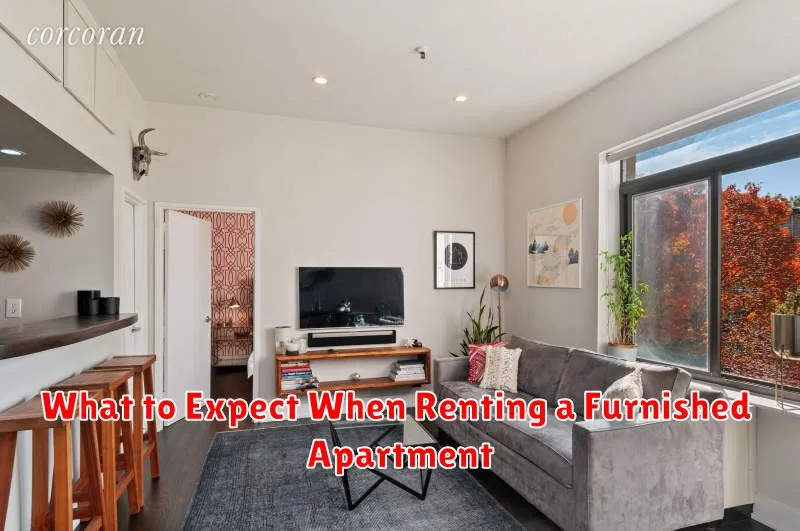Considering a furnished apartment rental? The allure of moving into a space complete with essential furnishings is undeniable, offering a convenient and often cost-effective solution for short-term stays, relocations, or those simply seeking a hassle-free living experience. This comprehensive guide outlines what to expect when renting a furnished apartment, from understanding lease terms and inventory lists to navigating utility connections and amenities. Whether you are a seasoned renter or a first-timer, understanding the nuances of furnished apartment rentals is crucial for a smooth and successful tenancy.
Renting a furnished apartment offers distinct advantages over unfurnished units. From eliminating the expense and logistics of moving furniture to the immediate comfort of a move-in ready space, the benefits are numerous. However, it’s essential to be prepared and informed about the specifics of furnished apartment leases, including what is included in the rent, the condition of the furnishings, and the responsibilities of both landlord and tenant. This article will explore the key aspects of furnished apartment rentals to help you make informed decisions and enjoy a positive rental experience.
What Comes Included?
Renting a furnished apartment typically means the unit comes equipped with essential furniture and appliances. This generally includes items like a sofa, bed, chairs, tables, and basic kitchen appliances such as a refrigerator, stove, and oven. The specific items and their quality can vary depending on the landlord, rental agreement, and price point of the apartment.
Often, essential housewares are also provided. Think cookware, dishes, cutlery, and sometimes even linens and towels. It’s crucial to clarify exactly what is included with the landlord upfront to avoid any surprises upon move-in. A detailed inventory list should be reviewed and agreed upon by both parties.
While furniture and appliances are standard, other amenities can vary significantly. Some furnished apartments may include extras like a television, washer/dryer, or small appliances like a coffee maker or microwave. Again, confirming these details beforehand is essential.
Check Furniture Condition

Before signing a lease for a furnished apartment, thoroughly inspect the condition of all furniture. This is crucial to avoid disputes later on. Look for any existing damage, such as stains, rips, tears, or broken parts.
Note down any imperfections, no matter how small. Ideally, take photographs and include them with the inventory list. This documentation serves as proof of the furniture’s state at the start of your tenancy. A detailed record helps protect you from being held responsible for pre-existing damage.
Don’t hesitate to ask the landlord or property manager about the age and history of the furniture. Understanding how well-maintained the pieces are can give you an idea of their overall durability and potential for future issues. A proactive approach in checking the furniture’s condition can save you time and money in the long run.
Consider the following:
- Functionality: Do drawers and cabinets open and close properly?
- Cleanliness: Are the furnishings clean and free of pests?
- Comfort: Are the mattress and seating comfortable enough for your needs?
Inventory List Agreement
A crucial aspect of renting a furnished apartment involves the inventory list agreement. This legally binding document meticulously details all furnishings and appliances included within the rental unit. Carefully review this document upon your move-in inspection.
The inventory list serves as a record of the property’s condition at the commencement of your lease. It protects both you and the landlord from disputes regarding missing or damaged items. It typically includes descriptions of each item, its condition, and any existing wear and tear.
Note any discrepancies between the list and the actual condition of the items immediately. Inform the landlord of these discrepancies and ensure they are documented and acknowledged. This protects you from being held liable for pre-existing damages when you move out.
Upon move-out, the landlord will use the inventory list to assess the condition of the property. Ensure everything is present and in reasonable condition, accounting for normal wear and tear, to avoid potential deductions from your security deposit.
Cost Differences Compared to Unfurnished
One of the most significant distinctions between furnished and unfurnished apartments lies in the cost. Generally, furnished apartments command a higher monthly rent than their unfurnished counterparts.
This premium covers the cost of providing and maintaining the furniture, appliances, and other included amenities. The specific price difference varies based on factors such as location, apartment size, quality of furnishings, and lease duration. A shorter-term lease for a furnished apartment will often have a higher monthly rent compared to a longer-term lease.
While the initial monthly rent is higher, renting a furnished apartment can potentially reduce upfront moving costs. You avoid the expense of purchasing furniture, appliances, and decor, which can represent a considerable saving, particularly for short-term stays.
Furnished Apartment Pros and Cons
Furnished apartments offer a convenient turnkey solution, especially for those on short-term assignments or relocating. Cost is a major factor to consider. While a furnished apartment eliminates the upfront expense of purchasing furniture, the monthly rent is typically higher than unfurnished units. Convenience is a significant advantage, as you can move in with just your personal belongings. However, the available furnishings might not align with your personal style or needs.
Flexibility can be limited. Leases for furnished apartments are often shorter-term, which can be a pro or a con depending on your circumstances. Space is another consideration. Furnished apartments are pre-filled, so if you have a lot of personal belongings, storage might become an issue. It is important to weigh the pros and cons carefully to determine if a furnished apartment is the right choice for you.

